In this post, we’ll cover White Lipped Python Care that is appropriate for either the Northern or Southern species. Despite a bad reputation, these snakes make great pets…
Last updated on February 1st, 2023 at 09:25 am
White-lipped pythons are one of the most impressive snake species. Famous for their iridescent blue hue, these snakes are active, alert foragers. In captivity, the most common species available is the Northern, or d’Albertis’, White Lipped Python (Bothrochilus albertisii), and the Southern White Lipped Python, (Bothrochilus hoserae). Both are hardy if captive-bred.
The main difference between the two is that the southern species is a little larger, and slightly more laid-back. Asides from that, they both require similar care and can make great pets.
In fact, the main them keeping them from being more widely kept is that they have a reputation for being aggressive, though personally I think it’s exaggerated. White Lipped Pythons are defensive rather than aggressive, mainly because many of the ones we see for sale are wild-caught.
In this article, we’ll look at their enclosure, substrate, heating, and water requirements. We’ll also look at their diet and temperament, so that you can find out if they live up to their fearsome reputation.
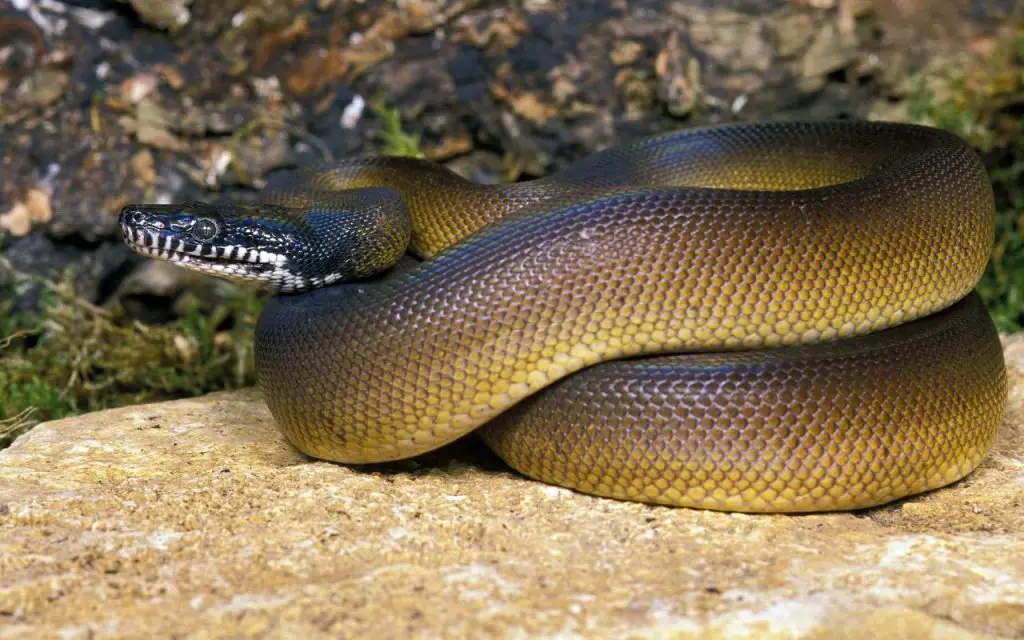
The Northern White Lipped Python
This species is primarily found in New Guinea island. They are sparsely distributed around some of the other local islands as well e.g. St. Matthias islands.
They thrive in rainforests that are located near water bodies. In captivity, there are two species in the genus Bothrochilus, which is synonymous with Leiopython.
These snakes are incredibly similar, but the Northern species, also known as the d’Albertis’ or d’Albert’s Python, is much more common in captivity. It also has more gold coloration on its flanks, which makes it a little more attractive to look at.
I’ve listed their classification below for reference:
| Order: | Squamata |
| Suborder: | Serpentes |
| Family: | Pythonidae |
| Genus: | Bothrochilus (Leiopython) |
| Species: | Northern White Lipped Python (Bothrochilus albertisii) Southern White Lipped Python (Bothrochilus horserae) |
*Note: There are other species of Bothrochilus/Leiopython, but taxonomists don’t always agree on how many.
These pythons have a unique head coloration that is iridescent and undergo color change as they mature. This coloration goes on throughout the ventral surface of the snake.
Overall the irredescence of White Lipped Pythons varies, but healthy specimens can rival the irredescence of Sunbeam Snakes.
Their gray eyes and narrow pupil indicate their nocturnal nature. Like all pythons, these species are extremely powerful constrictors.
They rest during the daytime under the forest debris and begin the hunt at dusk. Unlike many python species, they prefer to hunt rather than wait for the prey to come to them.
Having slender, prehensile tails, these species are also expert climbers. They use this ability to prey on animals of all shapes and sizes e.g. rodents, bandicoots, lizards, etc.

The size of a White Lipped Python
The size of an adult python of this species could range between 150cm to 210 cm (5-7 ft). The northern counterpart is shorter than the southern one, the latter can reach as much as 300 cm (around 9-10 ft).
Baby White Lipped Pythons, upon hatching from the eggs are around 12-15 inches (30-38cm) in length. It takes them 3-5 years to fully mature into an adult.
Though these lengths sound large, these are slender snakes. So a five foot White Lipped Python might only weight as much as a four foot Ball Python, for example. They are still what I would call a manageable size.
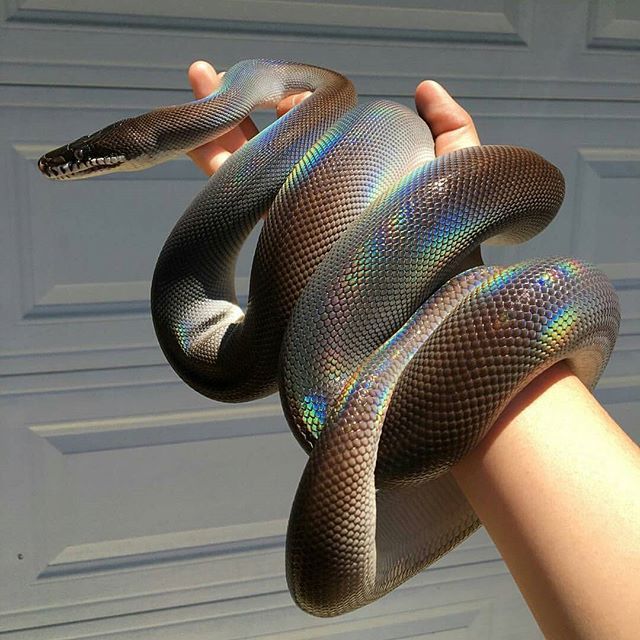
White Lipped Python enclosure
A small enclosure is a no-go, as these snakes are very active during nighttime. Furthermore, due to their active nature, they should have various hiding places and features to explore.
You can take your pick from plenty of caging options such as glass tanks, plastic boxes, PVC vivariums, and melamine vivariums. All these options have pros and cons in terms of expense, heat retention capacity, ease of cleaning and maintenance, etc.
Overall, I’d say the best options are a plastic tub for juveniles and subadults, then a PVC vivarium/terrarium for adults. Racks really aren’t great for this species, given how active and fast they are.
For the first six months to a year, young snakes do quite well in small plastic tubs. Such a setup allows for easy humidity control, helping the young snakes to shed their skin properly.
You can start with a plastic tub measuring 40cm x 30cm x 18cm (LxBxH). This will work nicely with baby White Lipped Pythons for up to a year. After that, you can move them into a PVC or melamine vivarium (we’ll discuss adult enclosure sizes in a moment).
Apart from paper towels, coconut fiber, bark chips, or damp moss can also be used as a substrate. The baby pythons will dig into whilst foraging and it will give them a little more enrichment when “hunting”.
After their first birthday celebration, you will need to move them into a bigger tub measuring 70cm x 40cm x 40cm. In this case, you’re better off using a soil substrate as it allows for easier humidity control.
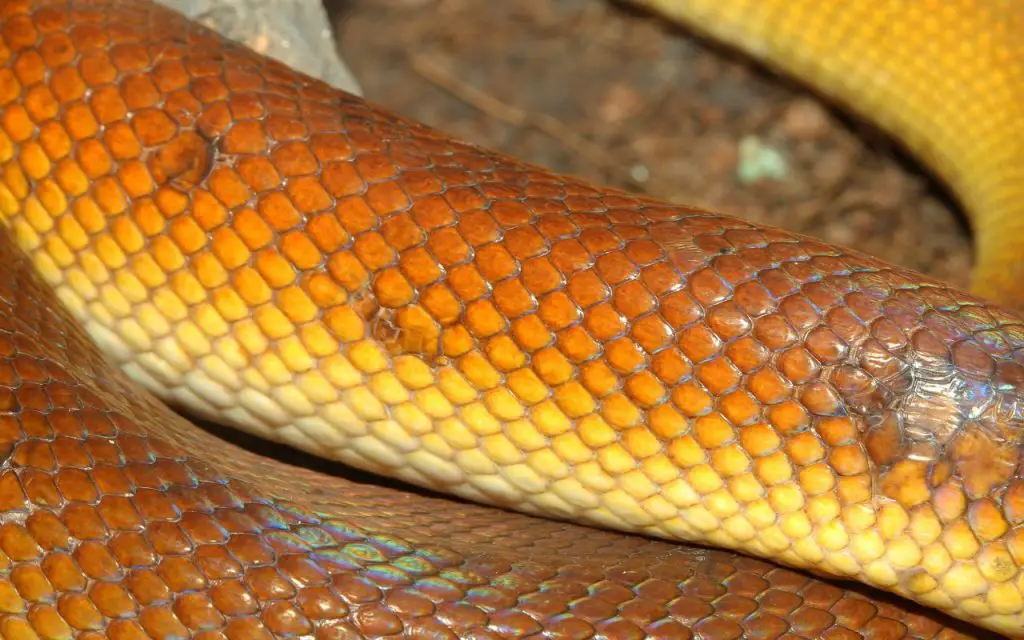
Design and hygiene
During the daytime, these snakes prefer hiding to avoid stress. So, you can put big pieces of cork bark in various positions inside, along with at least two hides or caves (one at each end of the enclosure).
In addition to this, damp moss can be put across the interior to help retain humidity. In the case of younger animals, you can put cardboard boxes, tubes, or plastic tubs inside where they can hide during the day.
Make sure to keep the bedding clean after they’ve been soiled. You will only have to do this once a month. After cleaning, disinfect their home and replace the bedding with a new one.
You can use a vinegar solution to clean the cage or F10 veterinary disinfectant. F10 has been found to greatly reduce the number of harmful microbes, all the while being safe for reptiles if used at the correct concentrations.

White Lipped Python enclosure size
For adults, you will need to have an enclosure measuring at least 120cm x 40cm x 40cm (LxDxH). However, for baby pythons, you can use an enclosure measuring only 40cm x 30cm x 18cm.
The size of your enclosure also depends on how many of these snakes you’re keeping inside it. These creatures must get plenty of room to carry out their natural activities properly.
Obviously, these snakes vary in size, so you might need a different enclosure size to what I’ve listed if your White Lipped Python gets over 6 foot long. With most snakes, the rule of thumb is to provide an enclosure that is equal in length to 60% of the snake’s full length.
That said, these pythons are active and fast-moving when fully grown, so I recommend an enclosure at least equal to 80% of a White Lipped Python’s length.
So, for a 7 foot (84inch) adult, you’d need a 5.5 foot (67inch) enclosure. If you couldn’t find a 5.5 foot enclosure, then you opt for the closest available size, which might mean a 5 foot one or a 6 foot one.
To help you out with this, I’ve added a calculator that will give you 80% of your snakes length below. Add your snake’s estimated full length in the top, and you’ll get 80% of it – your recommended enclosure size – at the bottom.
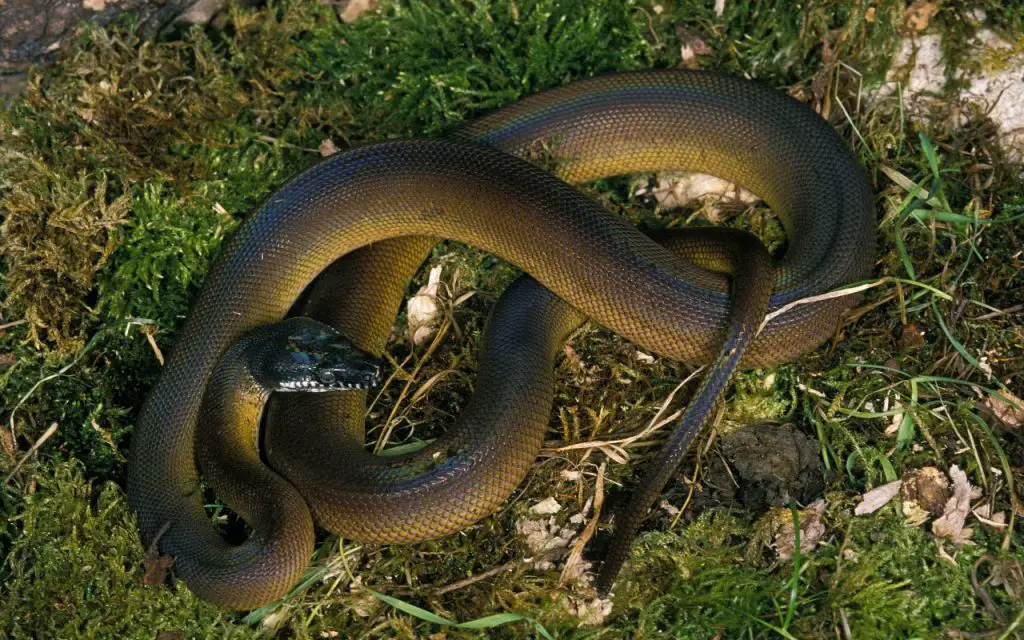
Substrate and Hiding Places
There are several substrate options for both baby white-lipped pythons and adults. In the case of the young ones, you can use damp paper towels, newspapers, coconut fiber, bark chips, damp moss, etc.
The main thing is that you choose something cheap and easy to replace, as babies pee a lot more than adults.
For adult pythons, it’s nice to use blended substrates consisting of sphagnum moss, peat moss, coco coir and orchid bark. This looks especially good if you’re using a naturalistic enclosure.
That said, any of the substrates listed below will work well:
- Coco chips
- Eco earth (coco coir) with sphagnum moss on top
- Cypress mulch
- Orchid bark
- Newspaper (this would obviously need changing more often)
Substrates you should NEVER use include:
- cedar – definitely toxic
- pine – may be toxic
- scented paper towels – can cause allergic reactions
The type of substrate you use has a major effect on the activity level of snakes. Substrate for these two species should always be good at holding humidity. If it gets too dry they quickly become uncomfortable.
Also by adding a leaf layer on top of the substrate you can eliminate malodor originating from the snake enclosure! Magnolia leaves, for example, are safe for reptiles.
For baby pythons, cardboard boxes work great as hiding places, However, for adults you need big sections of cork bark, resin caves or plastic hides to help them hide and feel safe.
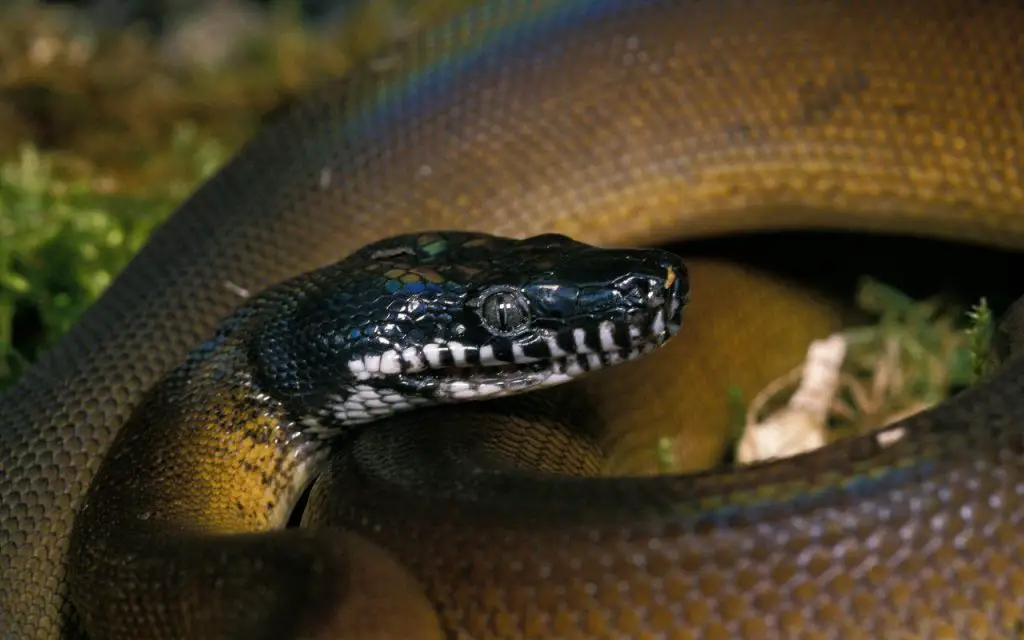
Temperature and Heating
These pythons thrive living in a temperature gradient inside the enclosure. This allows the snake to pick the suitable temperature for a specific time of day.
The living space should have a cooler side and a warmer side. You can use a radiant heat panel, heat mat, or ceramic heat emitter to make things warmer. Make sure to use a high-quality thermostat to avoid any severe fluctuations in temperature.
A daytime warm side temperature of 88-90F (31-32C) and a cool side temperature of 80-85F (26-29C) works well in most cases.
At night, the warm end should drop to 80-85F(26-29C) and the cool end 75F (24C). This should be adjusted for by a thermostat with a night time setting.
Notwithstanding, this isn’t essential so long as the cool end of the enclosure drops by a couple of degrees due to the ambient temperature in the room falling at night.
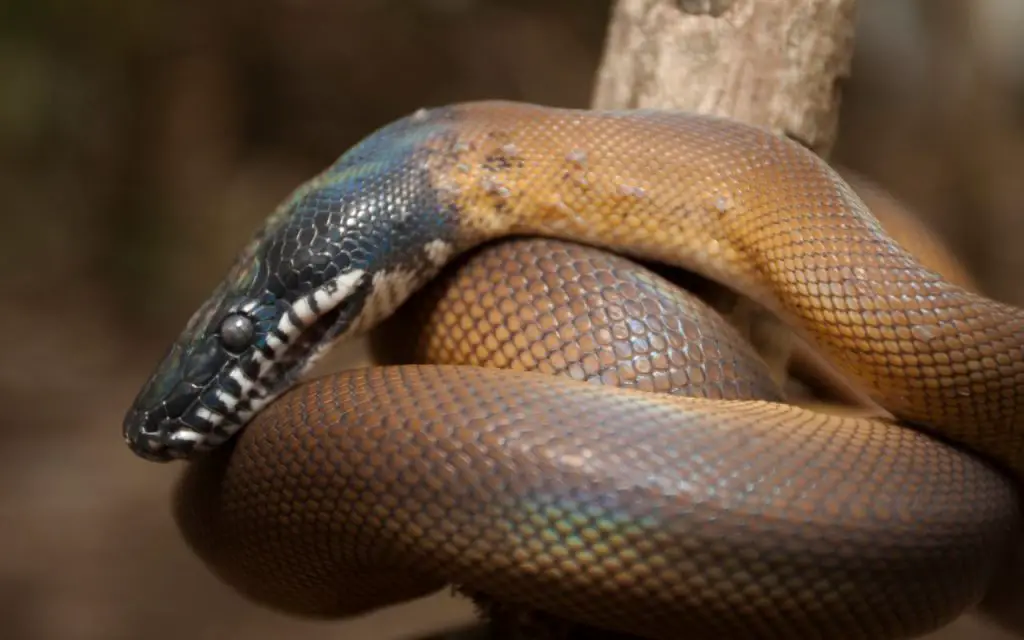
Basking area/warm end
Ensuring a constant temperature gradient is vital for the development of these creatures. In the enclosure, the warm end – or basking spot – should cover roughly 30-40% of the floorspace. For both species, the basking temp is 88-90F (31-32C).
You find out how much of your floor space is the warm spot by measuring the area of the heat mat you use, or using an infrared thermometer gun to test the area around a ceramic heat emitter or heat panel.
If you want to figure out how big your warm spot should be, please use our calculator below. Get your enclosure’s floorspace by doing length x depth (back to front). For example, the floorspace of a four foot by two enclosure would be 48in x 24in = 1152in.
When you’ve done this, add the result into the top box, and the bottom box will calculate what 30% of your enclosure’s floor space would be. This is particularly useful if you haven’t bought a heat mat yet.
Water Requirements
White Lipped Pythons forage near water in the wild, and seem have a great fondness for completely submerging themselves. It’s always a good idea to provide a water bowl large enough for them to do so.
Be aware that in warm enclosures, biofilm and bacteria build up rapidly in water bowls. Changing the water twice a week, and thouroughly cleaning the bowl is a big part of keeping your snake healthy.
Personally, I think porcelain bowls are best because you can really feel when they are clean by scrunching your fingers accross the inside surface.
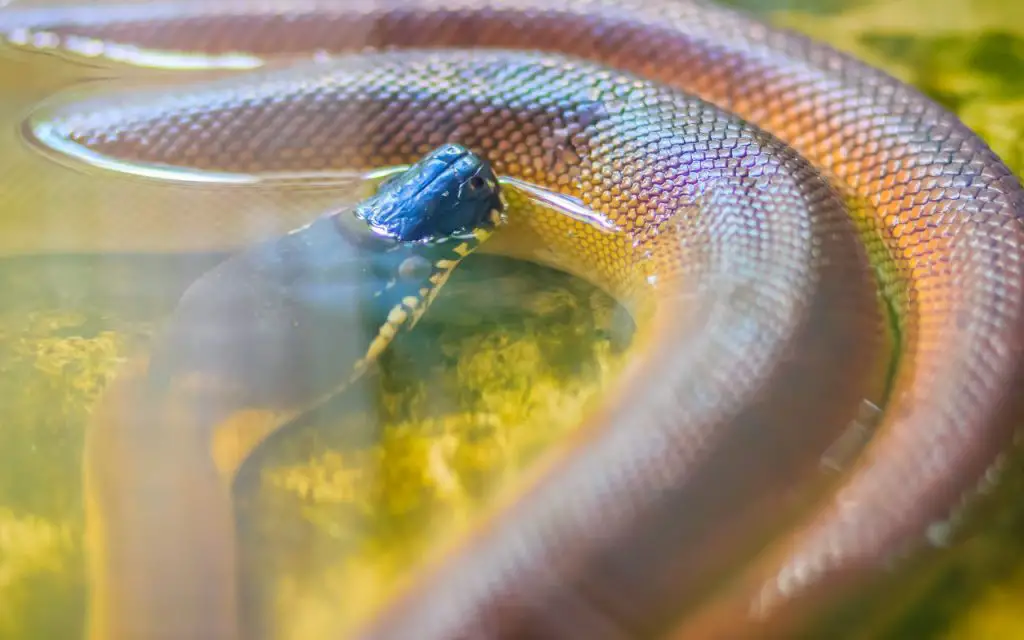
White Lipped Python Humidity
White Lipped Pythons are often found in and around rainforest habitats, where the ambient humidity is variable but soil humidity is almost always high.
In fact, rainfall in Papua New Guinea can be as high as 350mm a month, and humidity often hangs around 70-90%. As such, I recommend a humidity level of 70% in captivity.
Always make sure there is adequate ventilation as well – the air should be humid, not stagnant. Humid air = healthy shedding, stagnant air = disease! Your enclosure should not have air vents or holes, even if it makes maintaining humidity a little tougher.
Also, be sure to spray the enclosure a couple of times a week as needed, and have a hygrometer inside the enclosure.

Lighting
Being nocturnal White Lipped Pythons don’t need UV lighting to synthesize vitamin D3 and metabolize calcium – they extract it from their prey instead.
Notwithstanding, the do need some form of light. This is purely for their circadian rythm, so they know day from night. It doesn’t even have to be bright, just the ambien light from a window or a light in the room is enough.
Then again, there is nothing stopping you from using LED light strips or UV lighting in their enclosures. You have to remember two things, though:
- These snakes come from the equator – so their light should be on 12hrs a day and off 12hrs a night, all year round.
- They are shy and should always have ample hiding places where they can get away from light completely if they want to.

Feeding and Diet
You can give defrosted mice to the young ones roughly every 5 days in their first 3 months of age. They have a high metabolic rate at that age and can burn off calories quickly.
After that, you can feed them once every 7 days for the next 6 months to a year. Later on, when they are approaching adult size, reduce their feeding frequency to once every 10-14 days.
You need to keep a strict lookout on their body weight and condition to keep them from becoming obese. Light other pythons, they aren’t always great at watching their weight themselves. While feeding, you can use a snake hook to mitigate the chances of your being bitten by them.
For both juveniles and adults, the food offered should be just a little wider than the fattest part of the snake’s body. For juveniles, you can feed mice or young rats, and for adults you should feed rats.
White Lipped Python Temperament
These snakes are reputed to have a short temper which makes them less popular as pets. In truth, though, lots of people have bought wild-caught animals, which are always more defensive than captive-bred.
Captive-bred White Lipped Pythons are still a little jumpy, but are much more relaxed than wild-caught. I’ve witnessed several people handling ones that were raised in captivity and some of them do turn into gentle, harmless snakes.
Obviously, this only happens following a lot of patient, gentle handling by someone who doesn’t mind the possibility of getting nipped a couple of times. If you start off with a baby, those nips aren’t exactly going to hurt much, so this is something to consider: baby, captive-bred White Lipped Pythons are the way to go.
However, if you’re a novice, it is best if you start with friendlier species. Once the snake becomes familiar, you would be able to handle it. Although you may get bit at some point or the other.
This is because these snakes are much more anxious than a ball python and can never be held for several hours continuously.
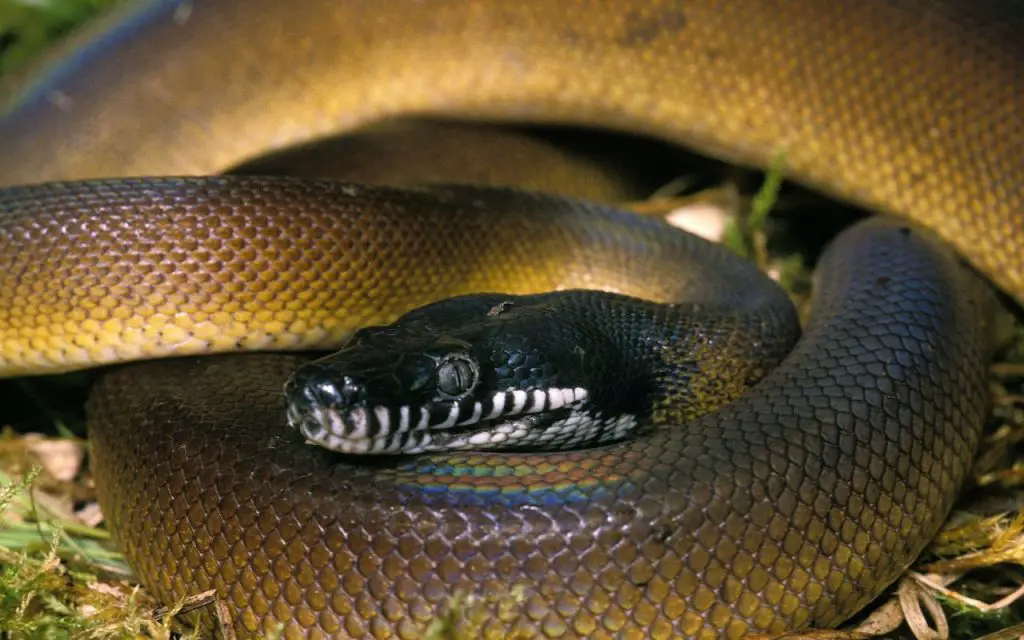
White-Lipped Python for Sale
My choice for sources reptiles is almost always Morphmarket, because all breeders who sell on there are subject to reviews. I feel this makes things safer for buyers.
Wherever you source your pet, though, I strongly advise getting a captive-bred snake – even if you have to wait a year or so for one to be available. Buying wild-caught reptiles is unecessary these days, and unethical when you think about it, especially when you consider the fact that a lot of imports die within months of arriving.
If you buy wild-caught animals, they may or not come with some of the following issues:
- severe stress
- long-term dehydration
- internal parasites
- external parasites
- infections of the skin or lungs
- novel viruses that could wipe out the rest of your collection
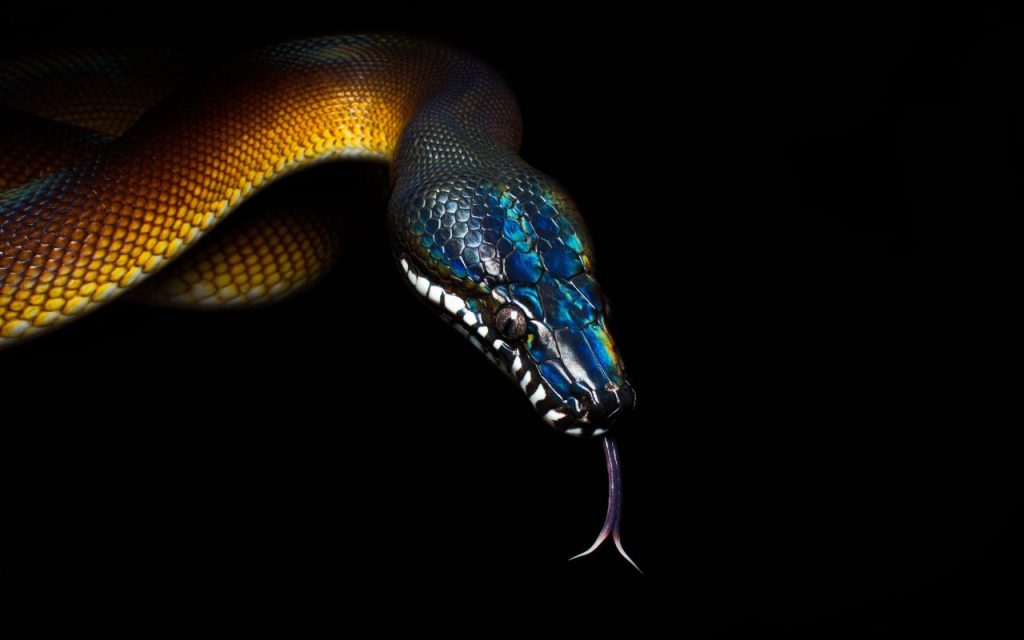
FAQ relating to White-Lipped Python Care
Are white-lipped pythons good pets?
It is very easy to rattle these snakes as they are a fast, defensive species. If you keep one, you’ll have to get into the habit of using a snake hook to remove them from their enclosure for handling, and give them the space and respect they deserve. On the plus side, they are gorgeous, inquisitive, and intelligent. Their irredescence is incredible to look at too.
If you’re an experienced snake handler, then captive-bred White Lipped Pythons make great pets. However, if you’ve zero to little experience, it is better to go for a more docile species. Good alternative species would be the little Savu Python (Liasis mackloti savuensis), or the Children’s Python (Antaresia childreni).
Do white-lipped pythons bite?
These snakes tend to bite if they do not want to be handled or feel threatened. That said, many of them get out of the habit if handled repeatedly from a young age.
If you handle a captive-bred baby twice a week for 5-10 minutes then it is entirely possible to tame it within 6 months. Just remember that they tend to remain flighty even if they don’t bite, so need extra care when approaching or handling.
How long do white-lipped pythons live?
With adequate care, these snakes can live up to 30 years. In the wilderness, they might not survive for more than 10 years, given how competitive an environment they come from.
Realistically, 20 years should be easily achievable in captivity if good attention is paid to husbandry. Correct temperatures, good hygiene and healthy frozen-thawed rodents will go a long way in achieving the best possible lifespan for a White Lipped Python.
White Lipped Python care summary
| Temperature: | Warm end 88-90F (31-32C), cool end 80-85F. Drop to 80-85F(26-29C) and 75F (24C) at night |
| Humidity: | 70% |
| Favourite food: | Rats or mice |
| Enclosure size: | Minimum 40cm x 30cm x 18cm for juveniles, 120cm x 40cm x 40cm for adults |
| Activity rythm: | Nocturnal |
| Lighting needs: | UV light not necessary, but ambient lighting beneficial |
